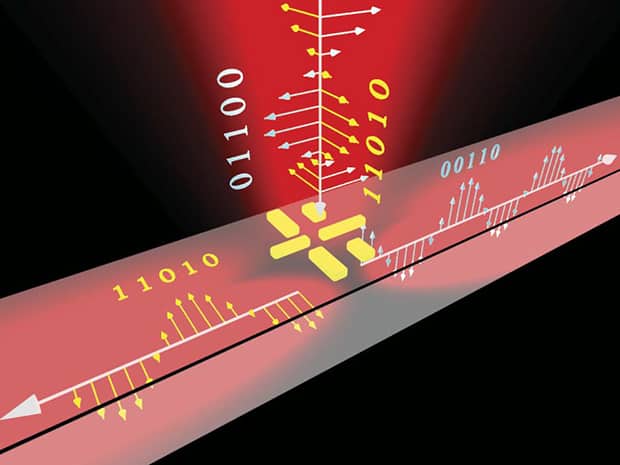The Internet is about to get a lot faster. A team of researchers led by the Australian National University was able to achieve an ultrafast-rate of bit transmission. This could mean the start of a new era for telecommunication.
Here’s how they achieved the impossible.
They stamped an optical nanoantenna on the optical waveguide which resulted in the fastest transmission of data to date. Using this, anyone can send data through light polarization in both directions. And that too at light speed, literally.
An Illustration depicting the nanoantenna and the optical waveguide
Before this study, the imprinting of optical nanoantenna on the waveguide was rare. There were hardly any instances where this technology was used and when it was used, the technology had very limited features. Therefore, until now, it was never used to its full potential.
How Does The Nano Antenna Work?
The phenomenon by which the nanoantenna works is called plasmonics. In this process, the electrons on the surface of the metal get excited by the light coming in. The wavelength of plasmon waves is even less than that of light. This makes it possible to make a device which is a lot smaller than those devices which depend on light.
What Did They Achieve In This Project?
The project was able to demonstrate that the antenna of sub-micron can not only sort but also select paths for data streams in different directions. This was possible by encoding the data in different polarizations of light.
But the real achievement was that Dr. Nashev, the leader of the research team, shrunk the optical device, which helped in the polarization, to an antenna which was smaller than a micrometer in size. This enabled the integration of this antenna into a silicon chip. The device does not work like the Yagi-Uda aerial which only polarized light in one direction. It has the capability of polarizing in horizontal as well as vertical direction.
This technology can revolutionize the telecommunication systems we have today. Right now, gold is being used in the silicon chips but once they are replaced by aluminum, it will become very easy to integrate it with our existing systems.
Via IEEE Spectrum























This is not for PTCL User :p
un ke liye sirf chitar hai.
Sad no data transfer rates is given despite the catchy title
“And that too at light speed, literally.”
Fiber optics work on the principle of light rays which obviously travel at speed of light. Metaphor gone literally wrong:D
the writer can work for Trump. what a legendary Spinner…….. :D
magr ptcl waley baaz ni ayeh gae….net slow hi rakheh gaye….
“”NOTE”” GUYS CHANGE YOUR DNS STTINGS TO GOOGLE PUBLIC DNS….AND FEEL 20% INCREASE IN PAGE LOADING AND SECURITY